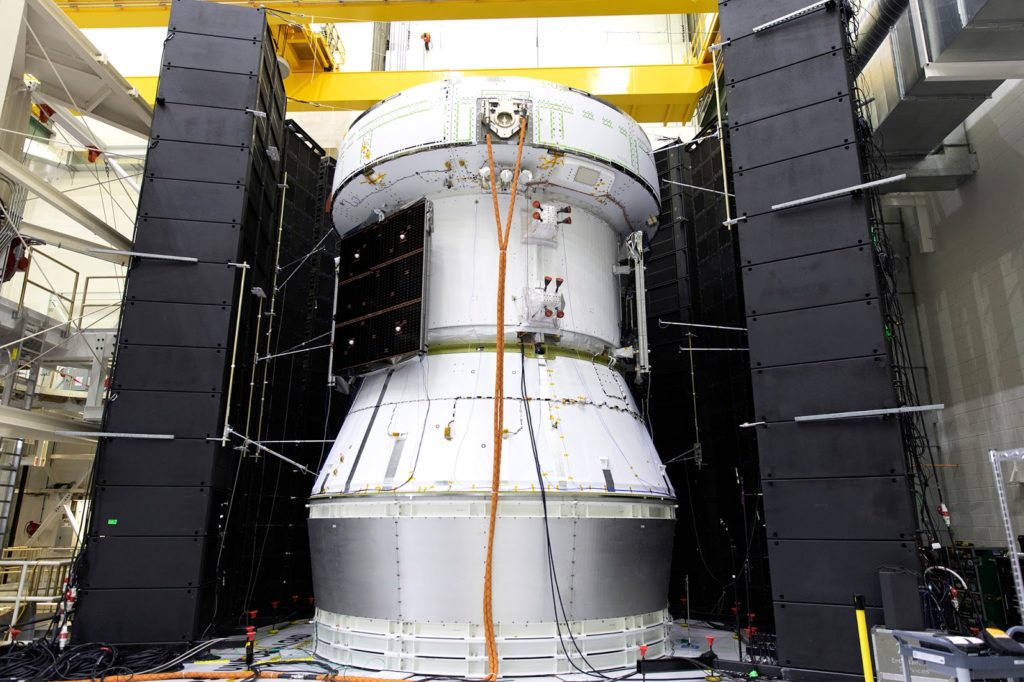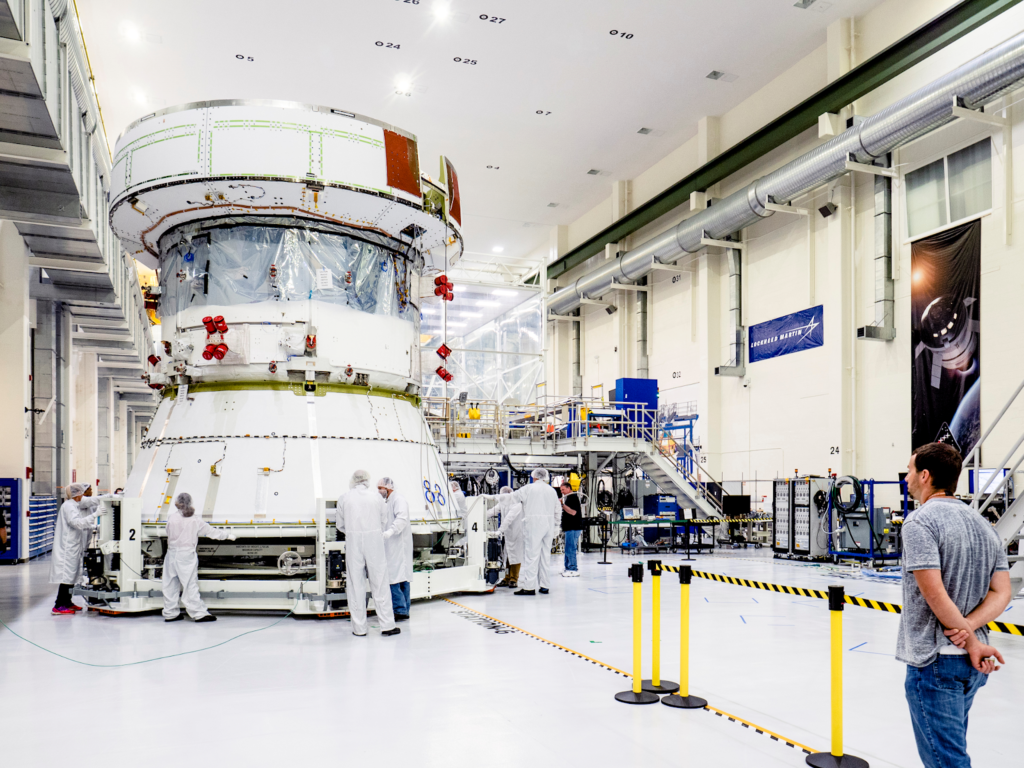Kremer — SpaceUpClose.com &
RocketSTEM – 12 June 2019
CAPE
CANAVERAL, FL – The European-built
service module for NASA’s Orion crew spacecraft has completed acoustic testing
inside the Operations and Checkout Building at NASA’s Kennedy Space Center in
Florida as critical work continues apace to prepare the vehicle for launch on
the Artemis 1 mission in late 2020.
NASA hopes to return humans to the surface
of the Moon at the lunar south pole by 2024 on the Artemis 3 mission under new
plans approved by the Trump Administration and announced by VP Mike Pence and NASA
Administrator Jim Bridenstine.
The acoustic testing on the combined
Orion European Service Module (ESM) and
Crew Adapter Module was completed on May 25, 2019 after completing the installation
of all four solar array wings on May 10.
“The tests were the latest step in preparing for the
agency’s first uncrewed flight test of Orion
on the Space Launch System (SLS) rocket,” NASA officials said.
The acoustic tests – called the Direct-Field-Acoustic
Testing (D-FAT) – are run to simulate the extreme noises of a rocket launch and
ensure the spacecraft will survive a real launch on the SLS from KSC Launch
Complex 39B.
For
the D-FAT test the service and adapter modules are “surrounded by large
speakers set at full blast to ensure the spacecraft survives the vibrations and
loud noise generated from the Space Launch Systems rocket liftoff.”
Sound bombardment
engineers are now running functional tests to determine whether the electronics
are still working correctly.
“Technicians will analyze the data
collected during the tests to check for flaws uncovered by the acoustic
environment. During the testing, engineers secured the service
module inside the test cell and then attached microphones, strain
gauges and accelerometers to it. They conducted a series of five tests, with
acoustic levels ranging from 128 to 140 decibels – as loud as a jet engine
during takeoff.”
The cylindrically-shaped
European Service Module ESM-1 is the critical ‘powerhouse’ element that will
supply NASA’s human-rated Orion spacecraft with electricity, propulsion, thermal
control, air and water and propel it on its first voyage to the Moon and 40,000 miles (64,000 km) beyond
atop SLS-1 during Artemis-1 from KSC pad 39B.
The first European Service Module (ESM-1) built to power NASA’s
Orion crew spacecraft for human voyages to deep space was unveiled at a welcoming
ceremony held at NASA’s Kennedy Space Center (KSC) in Florida in November 2018 –
see our photos – after being transported from Bremen, Germany where it was manufactured
for ESA.
The
next step this month is for the team to carry out the propulsion functional
test whereby “commands are sent to test the system and ensure everything
interacts as needed” – but not actually fire the engines.
The
propulsion test firings will be done later at NASA’s test facility in White
Sands, New Mexico.
All four
7-meter long solar wings were removed following the D-Fat test conclusion.
The next
big milestone will be mating of the ESM with the Orion Artemis-1 Crew module in
July into a unified 7.3 meter tall structure the size of a two-story house.
 |
| Orion Artemis-1 crew module under construction at KSC. Credit: Ken Kremer/kenkremer.com/spaceupclose.com |
Thereafter
the Orion Artemis -1 CM/ESM vehicle will be carefully loaded horizontally into
the belly of the ‘Super Guppy’ – NASA’s
one of a kind, gorgeous hybrid aircraft.
The Super Guppy will transport it from the
Kennedy Space Center to NASA’s Plum Brook facility for critical thermal vacuum,
acoustic, electromagnetic testing prior to the uncrewed lunar test flight. Launch on SLS-1 is scheduled
for late 2020.
in the Orion program is slated for July 2 involving the Ascent Abort-2 test from pad 46 on Cape Canaveral Air Force
Station. Watch for our upcoming coverage.
article will launch on a Minotaur 4 booster to more than six miles in altitude,
where Orion’s launch abort system (LAS) will pull the capsule and its crew away
to safety in a split second in a simulated rocket emergency during ascent on
the Space Launch System
rocket.
the SLS rocket from Kennedy’s Launch Pad 39B. The mission will take Orion
thousands of miles past the Moon on an approximately three-week test flight.
Orion will return to Earth and splashdown in the Pacific Ocean off the coast of
California, where it will be retrieved and returned to Kennedy.
 |
| Artemis 1 mission graphic. Credit: NASA |
Watch for Ken’s continuing
onsite coverage of NASA, SpaceX, ULA, Boeing, Lockheed Martin, Northrop Grumman
and more space and mission reports direct from the Kennedy Space Center, Cape
Canaveral Air Force Station, Florida and Wallops Flight Facility, Virginia.
Stay tuned here for Ken’s continuing Earth and
Planetary science and human spaceflight news: www.kenkremer.com –www.spaceupclose.com – twitter @ken_kremer
– email: ken at kenkremer.com
Dr. Kremer is a research scientist and journalist based in the
KSC area, active in outreach and interviewed regularly on TV and radio about
space topics.
Ken’s photos are for sale and he is available for lectures and outreach events






